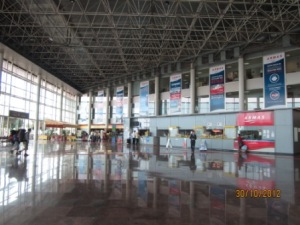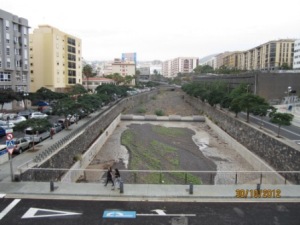
|
Santa Cruz de Tenerife
CAPITAL OF TENERIFE
Santa Cruz de Tenerife is the capital of Tenerife in the north east of the island, and is named after the cross which the conquistador, Alonso Fernandez de Lugo planted in 1493 when he invaded the island and claimed it for Spain. Since that time it has been the main centre for Spanish culture and business activity. It is a large and bustling city with buildings typical of the Spanish colonial rule, and full of examples of this historical legacy. The whole port area had been refurbished but in 2012 was under-going further extensive modernisation to ensure the city kept up its reputation as an attractive place to visit.
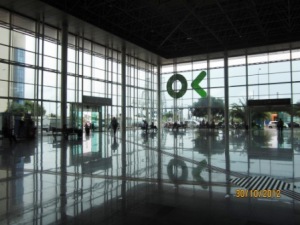 |
Santa Cruz de Tenerife has a very impressive multi-level modern bus station which clearly deals with a lot of traffic. Santa Cruz de Tenerife tiene una estación de autobuses modernos varios niveles muy impresionante que claramente se trata con mucho tráfico. |
|
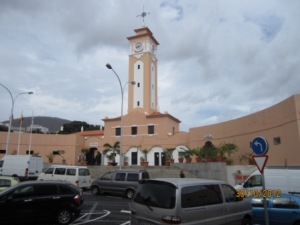 |
Not very far from the bus station is the delightful mercado de nuestra senora de africa. The lively looking pink architecture is matched by the bustle of a busy and popular market. No muy lejos del autobús estación es el encantador Mercado de Nuestra Señora de África. La arquitectura de rosa mirada vivaz es igualada por el bullicio de un mercado ocupado y popular. |
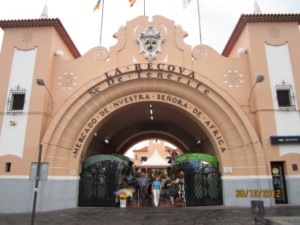 |
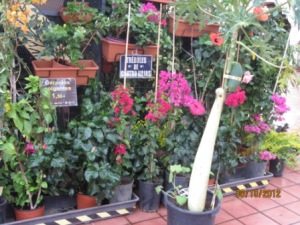 |
There is a full range of all the typical market stalls to peruse at leisure. Even in autumn the flower stalls are resplendant in colour. Downstairs there is a meat and fish market with every variety of produce you could imagine. Some of the fish are quite scary - see opposite:- Hay una gama completa de todo el mercado típico se detiene para leer en el ocio. Incluso en el otoño de los puestos de flores son brillante en color. En la planta baja hay un mercado de carnes y pescados con cada variedad de productos que te puedas imaginar. Algunos de los peces están bastante miedos - ver frente:- |
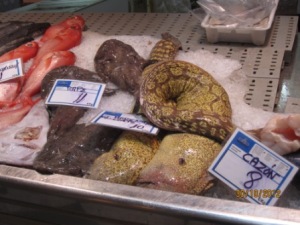 |
|
The Barranco de Santos is a wide river bed which flows from the mountains above Santa Cruz and through the middle of the city to the sea. No doubt when the snows melt and during heavy rainy periods there must be a deluge of water flowing down this steep barranco. This view is from the puente serador. El Barranco de Santos es un gran lecho del río, que fluye desde las montañas por encima de Santa Cruz y en el centro de la ciudad al mar. Sin duda cuando se derriten las Nieves y durante períodos de lluvia pesadas debe haber un diluvio de agua que fluye hacia abajo este barranco escarpado. Esta vista es desde el puente serador. |
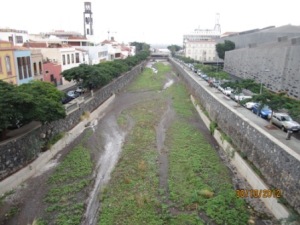 |
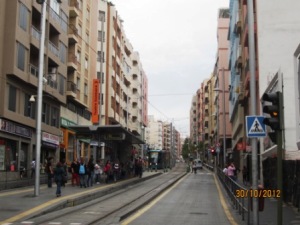 |
The centre of the city has many tall buildings and apartments. There is a busy tram line for transport between the centre of the city and the suburbs - see calle Angel Guimera on the left. There is a good level of pedestrian area also within the centre, for locals and tourists. The Calle de Castillo on the right has a good range of shops. El centro de la ciudad cuenta con muchos edificios y apartamentos altos. Hay una línea de tranvía ocupado para el transporte entre el centro de la ciudad y los suburbios - ver la calle Ángel Guimerá en la izquierda. Hay un buen nivel de zona peatonal también en el centro, para turistas y lugareños. La calle del Castillo, en la derecha, tiene una buena variedad de tiendas. |
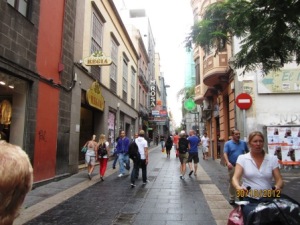 |
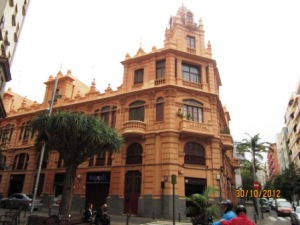 |
There are superb examples of former colonial times such as the building of the form tobacco factory 'La Lucha', which recall the period when the tobacco industry was booming. At the top of Calle de Castillo you find the Plaza Weyler with its imposing fountain sculted by Italian artists. It is an appropriate situation in front of the neoclassical Military headquarters. Hay magníficos ejemplos de la época colonial como la construcción de la fábrica de tabaco ex 'La Lucha', que recuerdan el período cuando estaba en auge la industria del tabaco. En la parte superior de la Calle de Castillo se encuentra la Plaza Weyler con su imponente fuente esculpida por artistas italianos. Proporciona que un muy necesario frondoso contraste con la arquitectura neoclásica más cruda de la sede militar. |
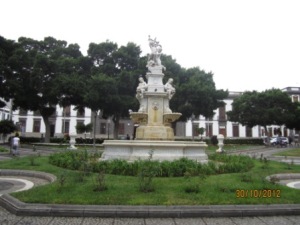 |
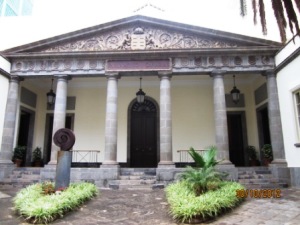 |
In the centre of town there is the grand building of the parliament of the Canaries. There is a modern building where clearly all the current activity takes place, and next door is the impressive colonaded building of the old parliament. Not too far away is the equally grand Museo de las Bellas Artes, which has works from many local artists as well as famous artists like Ribera, Brueghel and Madrazo. En el centro de la ciudad es el gran edificio del Parlamento de Canarias. Hay un moderno edificio donde claramente toda la actividad actual lleva a cabo, y al lado se encuentra la impresionante tanto edificio de el antiguo parlamento. No muy lejos está el igualmente gran Museo de las Bellas Artes. que tiene obras de muchos artistas locales, así como artistas famosos como Ribera, Brueghel y Madrazo. |
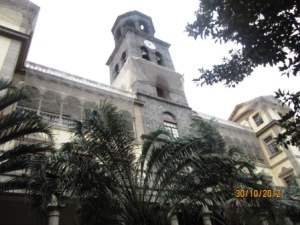 |
| In the 17th century the Fine arts museum had been a Franciscan monastery with a church attached. Now the church of St.Francis still remains and has been refurbished. It houses an impressive timber ceiling, two Retablos and wonderful organ. Historical records seem to suggest that the monastery was founded by Irish refugees fleeing anti-Catholic England in Elizabethan times. Certainly there is a rather incongruous bust to an Irish cleric/bishop in the small square near the front of the church (see image on right). | 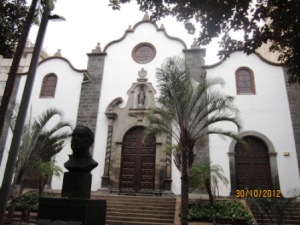 |
En el siglo XVII, el Museo de Bellas Artes había sido un monasterio franciscano con una iglesia que se adjunta. Ahora la Iglesia de St.Francis todavía sigue siendo y ha sido reformado. |
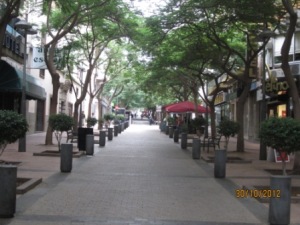 |
Much of central Santa Cruz is pedestrianised like the Calle de Castillo at the top of the busy Plaza de la Candelaria with the impressive Casino and Carta Palace. At the bottom of the Plaza is the famous white marbel Obelisco de la Candelaria sculpted by Pasquale Bocciardo in the 18th century. It represents the veneration of the image of the Virgin of Candelaria at the top of the sculpture. Gran parte de la central de Santa Cruz es peatonal como la Calle de Castillo en la parte superior de la Plaza de la Candelaria ocupado con el Casino y el Palacio de Carta impresionante.En la parte inferior de la Plaza es el marbel blanco famoso Obelisco de la Candelaria esculpida por Pasquale Bocciardo en el siglo XVIII. Representa la veneración de la imagen de la Virgen de la Candelaria en la parte superior de la escultura. |
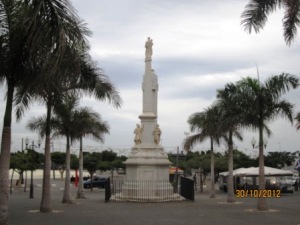 |
| The Plaza de España is perhaps the most recognized landmark in Santa Cruz de Tenerife. The fountain is one of the largest you will ever see at 50m diameter. This image shows the tall Monument to the Fallen overlooking the Plaza, with the tower of the Palacio Insular in the background. | 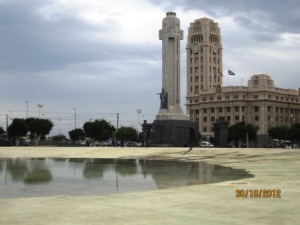 |
La Plaza de España es tal vez el monumento más reconocido en Santa Cruz de Tenerife. La fuente es uno de los más grandes que jamás verá en 50m de diámetro. Esta imagen muestra el alto monumento a los caídos con vistas a la Plaza, con la torre de la Palacio Insular en el fondo. |
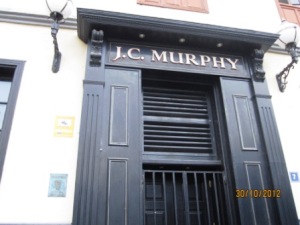 |
In the small plaza opposite the iglesia de nuestra señora de la concepción, stands another connection with the Irish community in Santa Cruz. It may seem rather bizarre to find an Irish pub so near to one of the oldest historic sites on the island, but there is obviously no limit to the popularity of the black liquid gold which is Guinness! En la pequeña plaza frente a la iglesia de nuestra señora de la concepción, se encuentra otra conexión con la comunidad irlandesa en Santa Cruz. Puede parecer extraño encontrar un pub irlandés tan cerca de uno de los lugares históricos más antiguos de la isla, pero obviamente no hay límite a la popularidad del negro oro líquido que es Guinness! |
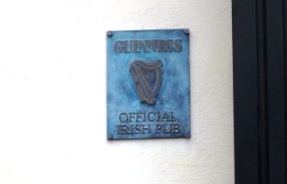 |
| The church of Our Lady of the Conception is one of the most famous landmarks on the island. It was built in 1502 shortly after Alonso Fernandez de Lugo first conquered the island, but has been rebuilt and refurbished many times. The tall square belfry towers over the area, and the whitewashed exterior gives the church a modern look. The cross of the Spanish conquerors is kept here along with British flags captured from Nelson during his abortive attempt to capture the island in the 1700s. | 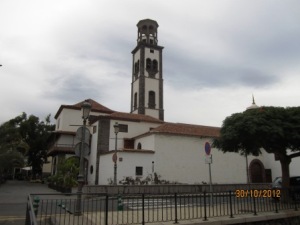 |
La Iglesia de nuestra Señora de la concepción es uno de los hitos más famosos de la isla. Fue construido en 1502 poco después Alonso Fernández de Lugo primero conquisto la isla, pero ha sido reconstruido y restaurado muchas veces. El campanario cuadrado alto domina toda la zona, y el exterior blancas da a la Iglesia un aspecto moderno. La Cruz de los conquistadores españoles se mantiene aquí junto con banderas británicas capturadas a Nelson durante su fallido intento de capturar la isla en el siglo XVIII. |
| If one goes across the Barranco from the church, you find the large Museum of Nature and Man. This has some superb exhibits charting the anthropology and archaeology of the island. They have created a replica of an old Guanche burial ground and also show examples of mummies from excavations on the island. | 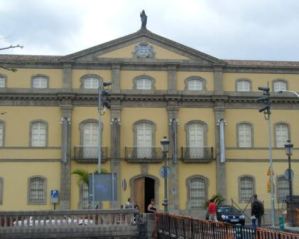 |
Si va a través del Barranco de la iglesia, se encuentra el gran Museo de la naturaleza y el hombre. Esto tiene algunas magníficas exposiciones trazando la antropología y la arqueología de la isla. Han creado una réplica de un antiguo cementerio Guanche y también muestran ejemplos de las momias de las excavaciones en la isla. |
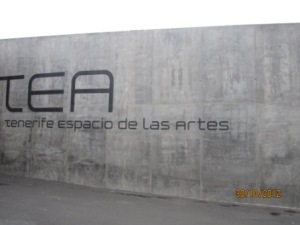 |
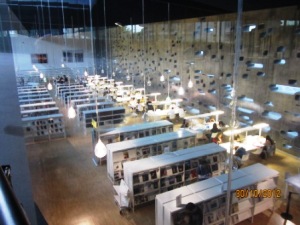 |
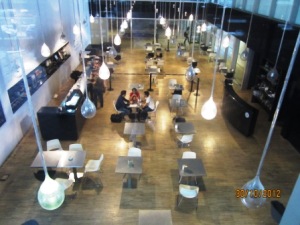 |
Next to the Museum of Nature and Man is the modern grey concrete building of the Tenerife Espacio de las Artes. Despite its ugly appearance, this centre is a great resource for the island. It houses the Oscar Dominguez Institute museum of contemporary art, the `isla de Tenerife` Photography Centre, and the Red Insular Library. Junto al Museo de la naturaleza y el hombre es el moderno edificio de cemento gris del Tenerife Espacio de las Artes. A pesar de su aspecto feo, este centro es un gran recurso para la isla. Alberga el Museo Oscar Dominguez Instituto de arte contemporáneo, la isla de Tenerife centro de fotografía y la Biblioteca Insular Roja. |
The Red Insular Library - La Biblioteca Insular Roja. |
The modern restaurant - El restaurante moderno. |
| The spectacular Auditorium of Tenerife was designed by Santiago Calatrava and completed in 2003. It is now seen as a symbol of the modern Tenerife (and Spain), and has won plaudits from all over the world. There are two halls: the main Symphony hall which seats 1600; and the smaller Chamber hall seating about 400. | 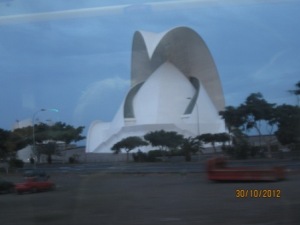 |
El Auditorio espectacular de Tenerife fue diseñado por Santiago Calatrava y se completó en 2003. Se ve ahora como un símbolo del Tenerife moderno (y España) y ha ganado aclamaciones de todo el mundo. Hay dos salas: la principal Orquesta Sinfónica con capacidad para 1600; y unos 400 de asientos de la sala más pequeña. |
| Next to the Auditorio is the delightful leisure park/swimming pool development of the Cesar Manrique Maritime Park. The famous designer from Lanzarote was asked to create something attractive in the old port area. The result was a stunning leisure park with a large pretty pool, sunbeds, palm trees and lots of other amenities. This development was one of the last works completed by Manrique before he was killed in a traffic accident in 1992. | 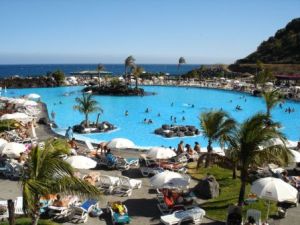 |
Al lado del Auditorio se encuentra el maravilloso parque de ocio/piscina el desarrollo del Parque Marítimo César Manrique. El famoso diseñador de Lanzarote se le pidió a crear algo atractivo en la zona del puerto antiguo. El resultado fue un impresionante Parque de ocio con una bonita piscina, hamacas, palmeras y muchas otras amenidades. Este desarrollo fue una de las últimas obras realizadas por Manrique antes de que murió en un accidente de tráfico en 1992. |
Other good places in Tenerife like Hotel Cleopatra
Copyright © and TM 2007-2024 fun-learning-spanish.com |
